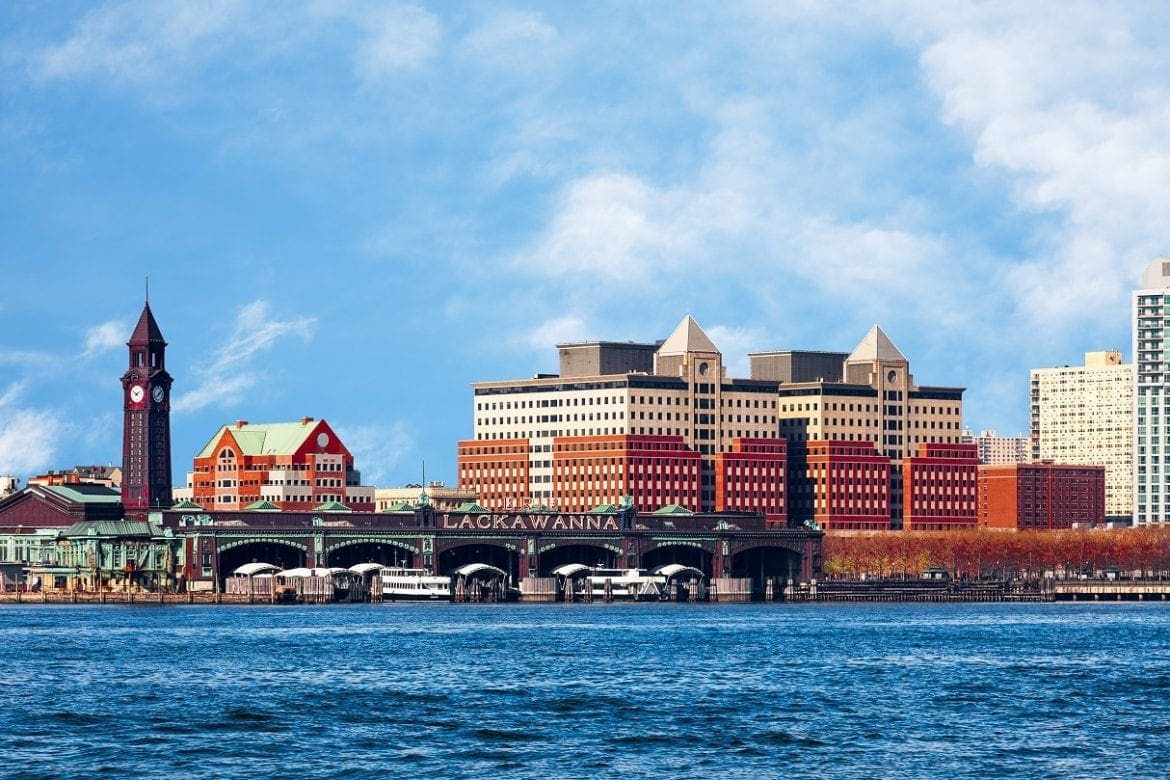The small city of Hoboken, New Jersey, often referred to as the “Mile Square City,” is just across the Hudson River from Manhattan. And it should be known for much more than just having “the most bars per square mile in the United States.” Hoboken has a surprisingly rich history. This history hasn’t been written only in recent years either, it stretches back well before the arrival of colonists. In what follows, I’ll seek to give a well-rounded but brief history of Hoboken, from it’s earliest interactions up to the present-day.
Despite being a mere two square miles in size, with a current population of roughly 50,000, Hoboken’s history is anything but small. With that said, let’s take a look at the history of Hoboken.
A Brief History of Hoboken
Before the Europeans
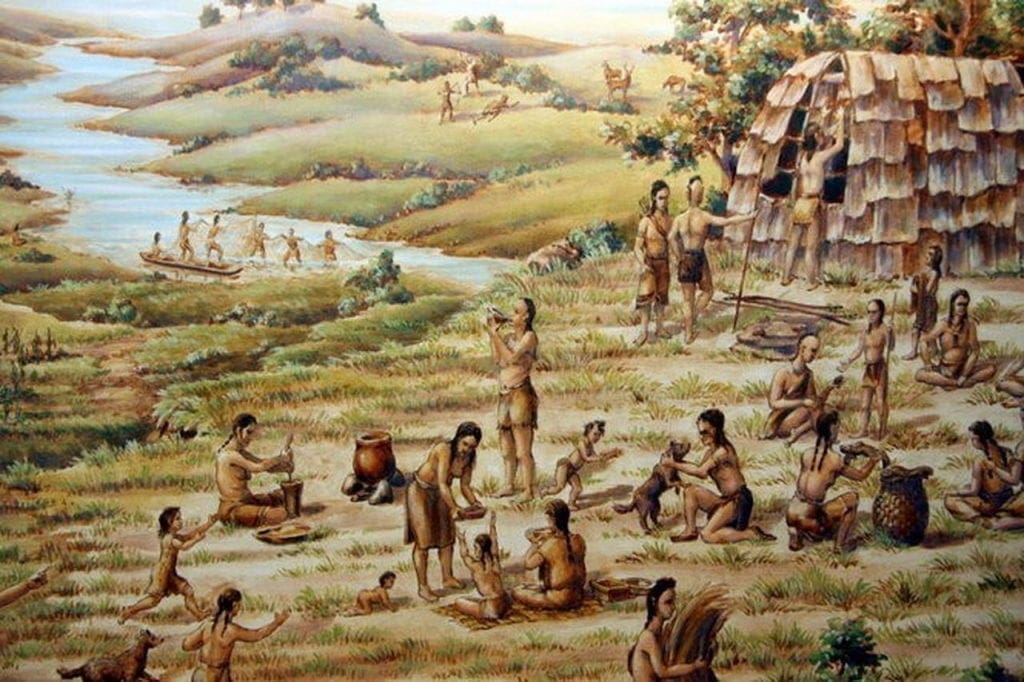
Photo Credit: A painting from the Lenape Collection at the Staten Island Museum
As is common knowledge nowadays, the Americas never were, in fact, the “New World.” Hoboken, in particular, was no different. The regions of Delaware, New Jersey, Southern New York, and Eastern Pennsylvania were inhabited and controlled by a tribe called the “Lenni-Lenape,” which means “Men of Men”, but is translated to mean “Original People.” It’s believed that around 1600, the tribe had 20,000 people throughout these regions. The Lenni-Lenape and other native tribes have been estimated to have ruled over these lands for some 10,000 years; yes, you read that right. The name “Hoboken” likely originated out of the native’s classification for the lands, which they called “Hopoghan Hackingh.” This translates to “Land of the Tobacco Pipe” and refers to the green-colored rock they used to carve tobacco pipes.
It’s unknown how long the tribe would’ve presided over the specific area of land that is now Hoboken. But we do know that when outsiders arrived, they were inhabiting this land. It’s said that Henry Hudson, the navigator the Hudson River is named after, was the first outsider to see the land of present-day Hoboken back in 1609. He made note of green-colored rock as well, which was abundant in volume and size. As you likely know, the arrival of colonizers in present-day America exploded around this time and seemingly never stopped.
The Clashing of Worlds
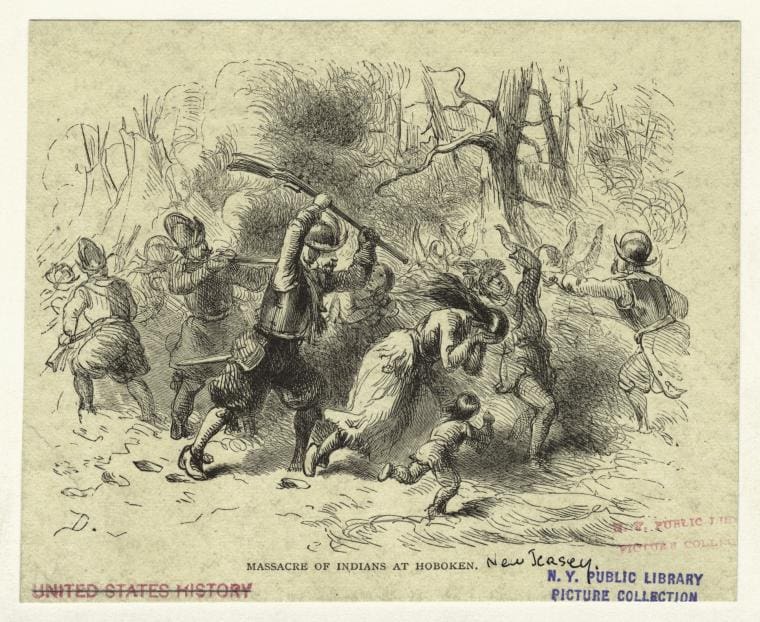
Photo Credit: New York Public Library Digital Collections
By the mid-1600s, the Dutch had a significant presence, particularly on the island of Manhattan. From the early voyage of Henry Hudson to this point of Dutch prominence, much happened between outsiders and the Lenni-Lenape including battles known as the “Pig War,” the “Whiskey War,” and the “Pavonia Massacre.” As you can imagine, these battles didn’t bode well for the Lenni-Lenape, nor do these account for the full extent of conflicts during the time.
In 1658, the Dutch bought the land where present-day Hoboken is, from the Lenni-Lenape. The Dutch traded for the land with wampum (used for jewelry), cloth, kettles, guns, blankets, and to top it off, beer. This sale of the territory represented just one of many similar occurrences in the area and in the country that seemingly marked the beginning of the end of Native American control in America. It’s likely the concept of land ownership was utterly foreign to the Native Americans. It’s expected the Lenni-Lenape interpreted this sale as an agreement to cohabitate on the land, not be removed from it. From this point on, the Lenni-Lenape faced more conflict, unfavorable treatment, displacement, or forced assimilation in New Jersey and beyond.
After the sale of the land, the Lenni-Lenape rarely appears in the history books of Hoboken, in particular. In present-day, however, they’ve combined with an additional tribe and are known as the Nanticoke Lenni-Lenape People. They’re a sovereign American Indian Nation and are considered the largest recognized tribe in New Jersey.
A New Hoboken
Arguably the most pivotal moment in Hoboken’s history happened in 1784 when Colonel John Stevens bought this once water-surrounded portion of New Jersey. He bought the land at a public auction, for what was then roughly $90,000. Stevens would go on to permanently settle on the name “Hoboken” and change the would-be city’s entire trajectory. He turned Hoboken into a getaway of sorts for New York City residents, building a waterfront walkway and public parks that eventually saw an estimated 20,000 New Yorkers every weekend.
Hoboken would go on to become a frequently visited and utilized place for celebrities of the late 18th and early 19th centuries after Stevens created what’s known as the “Turtle Club.” The club is considered the first American social club. The Turtle Club had many prominent members, including George Washington, Alexander Hamilton, Benjamin Franklin, and many more. The club eventually moved out of Hoboken many years later and into NYC, renaming themselves the New York Turtle Club. However, the club seemingly fell apart and out of prominence in the early 20th century.
The Legacy of Colonel John Stevens and His Family
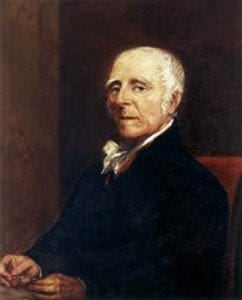
Photo Credit: Hoboken Historical Museum
Beyond giving Hoboken’s official name, Stevens and his family did so much to make the city into what it would become. Stevens, for one, brought it much attention and novelty. As an inventor, he received one of the first American patents, which he used for a steam engine application. Some years later, the steamboat Little Juliana, the first driven by twin-screw propellers, steamed across the Hudson River from battery park to Hoboken. In 1826, he also designed and built the first steam-driven locomotive in the U.S., which Stevens operated in Hoboken. These inventions not only brought attention to Hoboken but, in large part, led to it becoming a hub for transportation in the years that followed.
Though Colonel Stevens passed away in 1838, his family continued to build the legacy of Hoboken. Many of the 19th-century buildings that still stand today were erected due to efforts from his family. They also created Hoboken’s organized street pattern, which is present to this day. Their name is honored at Stevens Institute of Technology, one of the top engineering schools in the country. Which of course, is located in Hoboken.
Fun Fact
In 1846, the first-ever organized game of baseball took place in Hoboken. The ballgame took place on Elysian Fields, which is right near present-day Elysian Park. The game was between the New York Nine and the Knickerbockers. The final score was 23-1, with the New York Nine winning in four innings. Sorry Knicks fans, though this was baseball, it seems like this was the early warning sign for what was coming.
Hoboken, the Port City
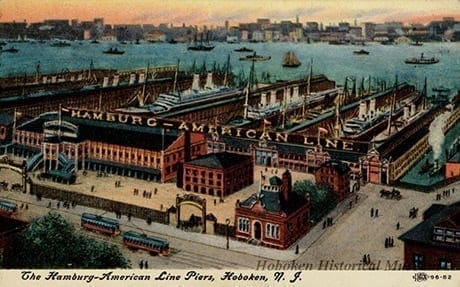
Photo Credit: Hoboken Historical Museum
Hoboken’s residents transformed the city into a rail and water transportation center, due to its increased popularity and favorable location near New York City and the Atlantic Ocean. It served as a major port for transatlantic shipping lines of the time. Further development of the city, and its new role as a transportation and shipping hub, contributed to its fast growth between 1860 and 1910. This growth made it a favorable destination for immigrants, influencing the city’s diversity since.
Hoboken’s role as a leading port city led to it playing a significant role in World War I. It served as the port of embarkation for some three million American troops during the time. Essentially, the city was the last stop for soldiers before being sent to the biggest war in history at the time. Hence comes the famous slogan: “Heaven, Hell or Hoboken… by Christmas.” Unfortunately, for many young American soldiers, Hoboken was their last stop on American soil.
Hoboken in Pop Culture
On a brighter note, Hoboken saw a glorious day on December 12, 1915, when Frank Sinatra was born there. Though he’d end up living elsewhere, Sinatra was born and raised right in Hoboken, New Jersey. In 1954, Director Elia Kazan filmed the classic American crime drama “On the Waterfront” in the Mile Square City, forever earning it a place in cinema history. This marked one of the earliest occurrences of a big motion-picture filming on-location rather than in-studio, which has since been common throughout New York City and cinema worldwide.
Downfall and Resurgence
Hoboken eventually met a fate similar to much of New York City in the 1970s: a complete economic downturn. Gentrification was prominent, and fires broke out, destroying buildings, businesses, and homes. Crime was also up, and the once critical shipping port had become outdated with containerization. Containerization brought about the need for bigger ships and bigger ports to handle the influx of containerized goods. This need was likely too much for the small Hoboken port to handle efficiently. This downturn of Hoboken essentially marked the end of the city’s classification as a blue-collar city.
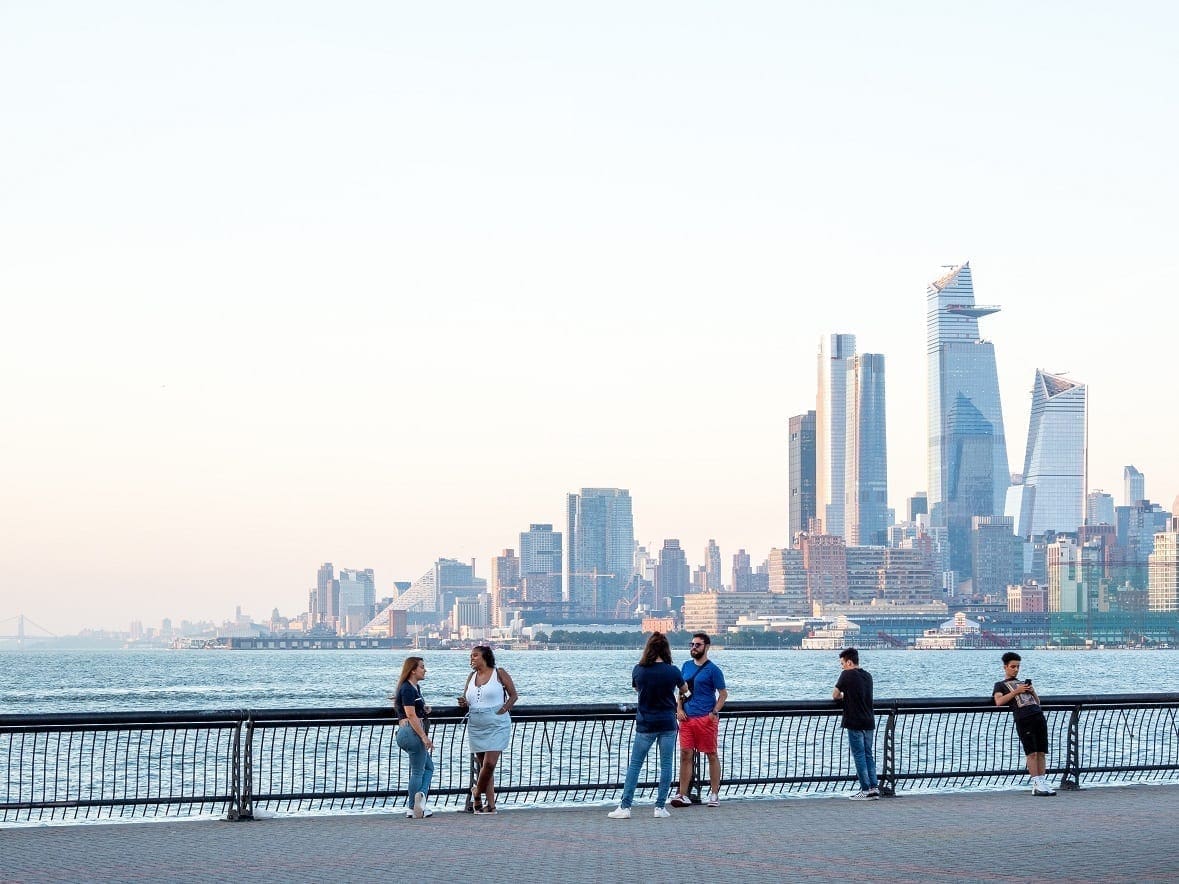
Today, Hoboken is full of mostly young people and New York City commuters. The once blue-collar city run by ports has in recent years, pivoted, with it now being considered a desirable spot for several other reasons. Hoboken is host to numerous festivals, bars, restaurants, shops, and much more. Despite its relative popularity, it still bears a small size geographically and in terms of population. It also remains a popular transportation hub for the tri-state area, given its proximity to NYC.
Much has changed throughout Hoboken’s history, but to this day, the little city still packs a large punch. With great views of Manhattan, endless activities, an influx of young residents, and a unique vibe, Hoboken likely has even brighter days ahead.
If you want to learn more, check out this cool, short documentary on the history of Hoboken from the 1970s:
About the Author/s
Garrett is a writer at The Digest. He currently lives in Astoria, NY, and loves writing about topics that make readers think. His passions include film, sports, traveling, and culture.
